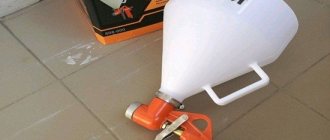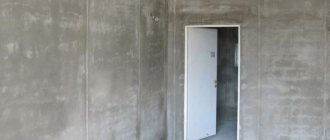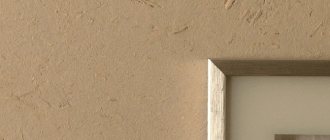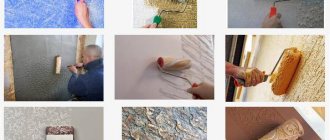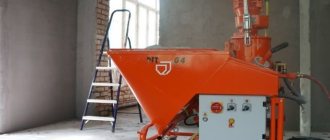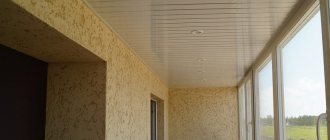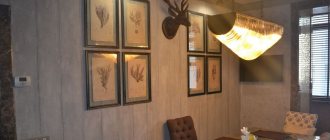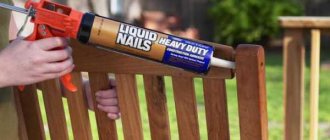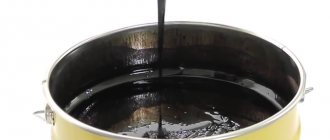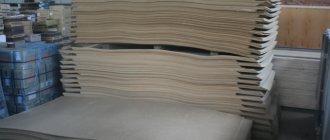Plastering is a rather labor-intensive process. A lot of time and effort is spent on covering surfaces with a layer. At the same time, you want the layer of plaster to lay evenly and tightly. Typically, a builder works with a ladle, throwing the mixture onto the masonry.
However, it does not lay down quite evenly. Cavities cause crumbling over time, frustrating repair efforts. Plastering when building a new home or renovating is the most difficult part of the finishing process. And the success and neat appearance of subsequent stages depends on its quality. This labor-intensive process takes days and weeks. You need skill for this.
Many people invite a specialist to help, but if the area to be treated is large (say, finishing the walls of a new house with mortar), then it will be expensive. With some skill and, of course, a great desire, you can plaster the walls yourself. The mechanical device cartouche “plaster gun” will help you with this. Applying plaster with a compressor will improve the quality of repairs, significantly speed up and facilitate the process itself, as it sprays the composition of any consistency.
Types of spray guns for applying plaster
As you know, today there are quite a few types of spray guns, with unique operating principles and spraying features.
Each tool is aimed at performing its tasks and working with materials of a certain degree of viscosity. Airless machines have low coating quality, but high productivity, therefore they are used for processing massive structures, mainly in industrial areas. Pneumatic devices, on the contrary, leave an almost perfect spray pattern and are very popular in decorative work or car painting. If you are looking for the optimal spray gun for plaster, putty and other mixtures of similar thickness, you should pay attention to the cartouche gun and its rougher analogue - the hopper bucket. We will talk about them in detail below.
Cartouche pistol
A very simple and compact sprayer, powered by compressed air pressure supplied by a compressor. Externally, it is very similar to a conventional pneumatic spray gun, but differs in nozzles of a much larger diameter. Most of these tools come complete with several replacement nozzles, the size of which affects performance and material consumption (the smaller, the lower). The pistol is equipped with an open top tank made of metal or plastic. It greatly facilitates the application of the plaster mixture, allowing you to process more than 100 m² of surface per day, with a layer thickness of 10 mm.
A similar spray gun for plaster is widely used in household work, saving the time, effort and money of zealous owners. Although the productivity of the device exceeds manual labor, it is still inferior to the capabilities of the next tool.
Hopper bucket
Large-sized, impressive machine for performing large volumes of work. Can be used for applying very thick and granular materials: from liquid wallpaper and plaster to cement-sand mixture. Consists of a holding tube connected to a bucket for loading material. An important role when processing large areas is played by convenient holders that allow you to securely grasp the tool with both hands. The device operates using compressed air supplied from the compressor receiver (cylinder).
The layer applied with a hopper bucket is quite uniform, but inferior in quality to a cartouche gun. At the same time, its productivity is 3-4 times higher, which allows you to treat a large area in a minimum period of time, without allowing the solution to dry out. The average volume of work with such a tool is about 60 m² per hour, with a word of 15 mm.
The average cost of a cartouche pistol and a hopper bucket is approximately the same, and is around 4000-5000 rubles. Both tools are capable of coping with spraying plaster, but the choice between them should be based on the tasks at hand.
Manufacturers of cartouche pistols
The minimum price of the device is 1,500 rubles, while a high-quality pistol can be bought for 3,000-4,000 rubles. The most popular among professionals are devices from the Brigadier brand (Switzerland) with aluminum funnels, which last a long time and are characterized by high build quality. Users also praise devices from Graco, Bosch, Fubag, Matrix, FIT, and Zubr.
Textured pneumatic gun Fubag Decor G5000
A cartouche gun is a necessary device in every finisher’s arsenal. It greatly facilitates the work, increases the evenness of the plaster application and reduces time wasted. Inexpensive household guns are useful even for home use; they will allow you to carry out repairs quickly, efficiently, and with your own hands.
Preparing a solution for a spray gun
First of all, pour the required amount of water at room temperature into the container. Pour in the dry mixture and mix the solution with a power tool and a whisk. To avoid splashes, the rotation speed should be set to minimum. The consistency of the putty, ready for application, should resemble thick sour cream.
Adding the mixture directly to the water helps to mix the solution more evenly. If, on the contrary, you add water to the mixture, then part of the solution on the bottom and walls of the container may not partially dissolve, which will make the mixture not so homogeneous.
You can prepare the plaster mixture yourself by mixing cement with sand in a ratio of 1 to 3. To make the solution more flexible, you can add a little detergent to the water in advance. More detailed and visual instructions for mixing the plaster mixture are presented in the following video.
How to care for your instrument
Even an expensive and high-quality tool can be damaged if it is used incorrectly and carelessly taken care of. To avoid faulty operation and failure of the gun, you must follow simple instructions:
- if it was not possible to use up all the solution, at the end of the work you need to drain the remaining solution from the container;
- bleed the air from the hose, and only then disconnect the gun;
- carefully unscrew the clamp and remove the funnel;
- Thoroughly rinse all removable parts (bucket, tube and nozzles) with water; you can use special detergents and, if necessary, a solvent;
- make sure that the gaskets are intact; damaged ones should be replaced immediately;
- periodically lubricate the trigger with oil;
- After cleaning, all parts and connections must be dried and kept disassembled until next use.
The gun should only be stored in a dry room - a humid environment promotes the rapid development of corrosion. Avoid direct sunlight, as this will adversely affect plastic buckets and rubber hoses.
The warranty period from the manufacturer is from 3 months to 1 year, the period depends on the model of the pistol and its cost. If you do not violate the rules for use and care, the tool will last for several years.
A cartouche gun for applying plaster and other building mixtures significantly simplifies the finishing work process, while physical fatigue is much lower than when finishing surfaces manually. Even without professional skills, more than 100 square meters can be processed per day. m area. Using a gun makes it possible not only to level or paint walls, but also to apply a decorative coating with a textured design.
Plaster spraying process
As stated in the first paragraph of the article, applying plaster with a spray gun is much more effective than the manual method. This tool saves effort and time, but has its own operating rules that must be followed if you want to get a layer of exemplary quality.
- The first and most important step, on which the evenness of the surface you create will depend, is the installation of beacons. This must be done strictly according to the level.
- As you know, plaster dries within 20-30 minutes, and if you do not have time to apply it during this time, it will be unusable later. Preparing a large batch of solution should only be done when using a hopper bucket with high productivity. The operating speed of a cartouche gun is at least 3 times slower, and for this tool you should not mix large volumes.
- The distance from the tool nozzle to the surface being processed is adjusted individually as work progresses. The average distance for a kaartushny gun is 30 cm, and for a hopper bucket - 6 cm. The main thing is to ensure that when spraying, the material does not splash off the wall.
- When the solution is applied, it is necessary to give it an even shape. For this task, a construction rule is used.
- Upon completion of work or during a break, it is strongly recommended to immediately rinse the tool so that when using it again you do not waste a lot of time scraping off dried material. It is enough to immerse the hopper bucket in a container of water and apply air pressure to it for purging. The process of washing the texturer is identical, but instead of immersing the tool in a container, water is poured into the tank and also sprayed under pressure.
Source
PLASTER HOPPER BUCKET FOR WALLS WITH HANDLE E-01 5390
| Number and size of nozzles | 4 things. 20 mm each |
| Material feed hopper material | Stainless steel (rivet) |
| Minimum compressor output capacity | 350 l/min. |
| Surface to be processed | Vertical (walls, etc.) |
| Hopper volume for texture material | 3.5 l |
| Optimal compressor output performance | 370 -400 l/min. |
| Optimal layer thickness | 2.5 - 7 cm |
| Optimal distance from the surface to be treated | 5-25 cm |
| Operating pressure | 6 atm. |
| Connector | threaded 1/2" |
| Tool type | Pneumatic |
| EQUIPMENT | |
| User manual | 1 PC. |
| Package | Branded cardboard box (the bucket is sold assembled and corresponds to the image in the product card) |
- PLASTER HOPPER BUCKET PG-01 FOR APPLYING ALL EXISTING DECORATIVE COATINGS AND LIQUID WALLPAPERS
- PNEUMATIC HOPPER BUCKET ER-01
(4912) 99-87-79 , 20-66-36, 25-18-67, 99-33-97
Customer Service: (4912) 99-18-97
© 2008-2021 LLC GC "TechNavi"
developed in the WEB UP studio —>
The tehnavi.ru website is for informational purposes only and no information published on it under any circumstances constitutes a public offer as defined by the provisions of clause 2 p. 437 of the Civil Code of the Russian Federation. To obtain detailed information about the goods, services sold and their prices, you must contact the managers of TekhNavi Group of Companies LLC by calling the company phone numbers or writing an email
For more details, see the Information
By continuing to use the website, you agree to the above conditions, otherwise we ask you to leave this resource.
What it is
A hopper bucket (plaster shovel) is a plastering device that uses air pressure to spray plaster over the surface of a wall. A pneumatic bucket is used for mechanized application of cement-sand or gypsum mortar when leveling walls, as well as for decorative finishing using acrylic plasters or “liquid wallpaper”.
According to the principle of operation, a pneumatic bucket is similar to a cartouche gun, but differs from it in configuration, greater productivity, larger nozzles and their number.
The ladle structure is shown in the diagram:
Operating principle: a plaster solution is applied to the ladle (hopper), or it is simply scooped out of the container. A hose from the compressor is connected to the handle; when the trigger is pressed, compressed air enters the hopper, passes through the hopper and, together with the plaster, flies out through the nozzles, spraying the mixture along the wall.
- High speed of finishing work. One person can plaster about 60 m2 per hour, which is 3-4 times faster than manual application of plaster.
- Suitable for any mixtures (cement-sand, gypsum, clay, lime, glass fiber concrete, waterproofing, liquid wallpaper, etc.). The permissible particle size in the solution is up to 10 mm.
- Due to the high impact force of the solution on the surface, the adhesion of the applied material and the strength of the coating increase.
- The weight of the equipment with a metal ladle filled with plaster is about 10 kg.
- Splashes from the sprayed solution fall on the floor and clothing. Hand plastering is cleaner.
Features when working with the device.
As already mentioned, most often gypsum mortar is used for mechanical plastering. There are several reasons.
Firstly, it is more elastic and fine-grained. It mixes well and slides well along the walls of the funnel. Secondly, gypsum solutions do not get stuck even in the narrowest nozzles. Thirdly, they are quickly prepared and consumed. With this mixture things go faster. Fourthly, during finishing the gypsum mixture can be tinted. Preparatory steps for mechanical plastering. Step 1. First, the surfaces are impregnated with a primer. Step 2. The walls are marked with beacons. They are installed at a smaller distance than the width of the rule so that the layer can be leveled. You can attach these beacons to cement, wait until it hardens, and start plastering.
Step 3. Prepare the compressor and cartouche gun for plastering the walls, turn on the unit and fill the container above the barrel. Bring the nozzle to the desired height and press the start handle. Further actions were described above.
Types of plaster shovels
Depending on the purpose, there are two types of pneumatic buckets:
- Wall. Designed for plastering walls and corners (looks like the photo above). Sometimes it has an additional handle on the hopper for convenience.
- Ceiling. Designed for applying plaster to ceilings and ceiling areas. Especially for this purpose, the angle of inclination of the hopper relative to the handle, as well as the nozzles in the hopper, has been changed. The extended handle allows you to raise the hopper bucket higher without the use of stepladders and supports. All this allows you to work comfortably in a vertical position, without fear of the mixture falling out of the hopper.
Operating principle
During operation, the unit ejects decorative solution from the nozzle at a certain angle. The composition of the cartouche gun for plaster includes:
The set of nozzles determines the density of the plaster solution. If thick compounds are used (for example, gypsum), the diffuser nozzle of the plaster gun is made at a bell angle of 30-45 degrees to increase the area of spraying the solution and increase productivity. For liquid solutions (used infrequently), the angle does not exceed 15-20 degrees, due to which the speed of work is maintained and the solution does not flow over the surfaces being treated.
According to user reviews , a plaster gun will be ineffective when used to speed up the application of a regular mixture (or when leveling walls). For a thick solution, you will need a lot of air and pressure created by the compressor, otherwise the mixture begins to quickly spread, and the inside of the cone is filled with its remains. The rather high initial density of the solution requires a very powerful compressor (nominal pressure 6-8 at, flow rate from 1000 l/min).
Decorative plaster is applied in a thin layer using the spraying method. Accordingly, the compressed air flow and pressure values will be less .
Hopper bucket or plastering gun
A gun for applying plaster could be classified as a pneumatic tool, if not for its competitor - the hopper bucket. The difference between the devices is as follows:
- In the ladle, the solution enters a separate container; there is no connection with the air supply line.
- The spray area does not depend on the angle of expansion of the angle, but on the angle at which the air masses enter the container with the solution.
- The hopper requires less pressure to operate, since there are no hydraulic losses when moving compressed air in the tube.
The undoubted advantage of a cartouche gun is that there is almost no loss of the working mixture; it will be directed and sprayed purely by the movement of the nozzle. The cost of the equipment is low; it can be used to apply any textured plasters without any problems, which is practically impossible to do with the help of a hopper-bucket.
The number of ornaments will increase significantly after purchasing an additional set of nozzles for the gun. This is not a difficult task, since the diameters of the connections are unified .
How to use cartouche pistols
The quality of mechanized application of decorative plaster on walls depends on the skills of the master. In almost all cases, a plaster gun will work well if you adhere to the following parameters:
- The air pressure required for spraying is 200-250 l/min.
- The thickness of the mixture laying layer is 10-12 mm.
- Excessive compressor pressure 3.5-4 at.
- The distance between the end of the device and the wall is set depending on the density of the mixture: for gypsum textures you will have to push the nozzle almost to the wall itself, and for rarer mixtures maintain a distance of 200-250 mm.
- To improve the quality and appearance of the coatings, it is recommended to use the unit in two steps, giving two layers with a smaller thickness: during the second pass, you can eliminate the shortcomings by waiting until the solution has completely set.
The work will require significant physical effort from the operator, so it is not recommended to treat too large areas at the same time. Experts advise working with areas of 1.5-2 m. Taking into account the likely losses, to treat such a surface you will need about 25 kg of plaster mortar (do not completely fill the upper funnel).
During the work, you should also pay attention to the fact that the plaster can splash outside the walls or facade, so it is necessary to provide the worker with a respirator and a protective helmet. You may also need protection from impact-resistant acrylic. It must be used when working with small stone chips so that its particles cannot get into a person’s eyes.
Connection kit
Let's consider what else is needed to connect and operate the plaster shovel.
The Huck adapter with internal thread is screwed onto the tool handle. Another coupling with a nipple is inserted into the hose and clamped with a clamp. The connection of the two couplings is very simple, just align them and turn half a turn. In the same way, the other end of the hose is connected to the compressor.
Choose a rubber hose A smaller cross section will not be able to provide air supply up to 350 l/min. The hose must be reinforced with threads in order to withstand the pressure of the supplied air and not lose mobility in the cold (not become stiff). Pay attention to the marking, choose “VG” - water / gas.
Operating principle
The device works by ejecting a decorative plaster solution from a nozzle at a certain angle. The cartouche pistol consists of the following parts:
- Steel short barrel.
- Nozzles with a set of various nozzles, the shape of which determines the pattern formed on the wall.
- A cone-shaped funnel - a container for the solution (its volume for effective use of the gun must be at least 3...5 l).
- Handles with a trigger lever that turns the gun into operation.
- Housings with a round suction tube - a nozzle, in the rear part of which there is a threaded connection to a high pressure hose.
- Hollow purge rod for clearing clogged holes.
The set of nozzles is determined by the density of the plaster solution. When using thick compositions (for example, gypsum-based), the diffuser nozzle for a cartouche gun is made with a bell angle within 30...45° - this increases the spray area of the plaster solution and increases productivity. For much less frequently used liquid solutions, the nozzle angle is reduced to 15...20°, due to which the solution flow rate remains the same and the plaster does not flow off the surface of the wall being treated.
As user reviews show, a cartouche gun is ineffective as a means of mechanizing the work of applying conventional plaster (or for the process of leveling walls). A thick solution requires high air flow and pressure created by the compressor, otherwise the mixture quickly slides, and the internal cone of the funnel becomes clogged with its residues. The reason is that the process of sucking plaster into the nozzle for a cartouche gun is divided into two stages - sucking the solution into the nozzle, and then pushing it out into the diffuser of the nozzle. With a sufficiently high initial density of the plaster mortar (at least 1500 kg/m 3 ), a very powerful compressor will be required, with a rated pressure of at least 6...8 atm, and a flow rate of at least 1000 l/min.
Unlike the main one, decorative plaster mortar is applied in thin layers using the spraying method. Accordingly, the compressed air flow and pressure values may be lower.
How to make it yourself: drawings and dimensions
The hopper bucket has a fairly simple operating principle, so craftsmen independently make pneumatic devices for plastering walls. This makes sense for a one-time small amount of work, or when you need to make a pneumatic bucket for an existing small compressor.
You will have to spend money on a blowing air gun and small components; the tank can be made from what you have at home: stainless steel, tin or a plastic canister.
Let's consider several options for a homemade plaster shovel.
From tin
- Let's make a tank. We draw according to size on a sheet of cardboard, then transfer the pattern to a metal sheet and cut it out. The edges can be secured by welding, rivets or bolts. Holes with a diameter of 18 mm are drilled under the nozzles using a crown.
It turns out something like this:
How to do it yourself is shown in the video.
From a canister
You can make a simple spray gun for plaster from a plastic canister, for example, an oil can. Let's look at it step by step.
- Cut out the bottom of an empty canister.
- Drill a hole d 10 mm in the lid and neck.
- Cut the handle of the canister lengthwise. Cover the holes inside the handle (for example, with polystyrene foam) so that no solution remains in it.
- Insert a blow gun into the slot in the handle. Its nozzle should be 2 cm from the hole in the lid.
- Secure the gun in the canister by wrapping it with wire and tape.
Result in the photo:
Applying plaster (video)
Plastering walls using a compressor is quite simple. After filling the tank with the solution, you need to hold the hopper at a distance of 5-10 cm from the wall and, turning on the air supply, apply the plaster from the bottom up.
Then the solution is leveled using the rule. They also move from bottom to top, guiding the rule along the beacons (if they have been installed).
Decorative plaster is sprayed in the same way as leveling plaster.
Important! Don't forget to rinse the ladle after use. To do this, lower its tank into a bucket of water and blow it with air.
The video below shows interior finishing using a mini plastering station.
3 Instructions for plastering walls
Among the main advantages of using a cartouche gun for decorative and textured plaster, experts highlight the following:
- High speed. You can cover up to 120 square meters per day. m of area, which significantly saves time and energy.
- High-quality layer density due to high pressure and particles of the finest possible fraction. This contributes to a more uniform coating that adheres well and is not prone to premature delamination.
- Acceptable cost of equipment and its durability, subject to operating conditions.
Work with plaster mortar begins with proper and high-quality preparation of walls, ceilings and other surfaces. All cracks, chips and old coating are covered with special mixtures, then the working area is cleaned, degreased and, if necessary, primed. The room and those areas that do not need to be treated are covered with plastic wrap or newspaper with masking tape, especially if the flooring is new or there is furniture and other items that can be damaged.
Afterwards, according to standard technology, rack beacons are installed using a rule, a building level and a thread, so that the step of one rack allows you to adjust the mixture during application. After this, install the compressor on a solid and flat surface and connect the device. The hoses are connected to the high-speed tube, the bucket is washed and cleaned if necessary, and the condition of all components of the mechanism is checked.
Hold the gun level, at waist level or higher, so that it is perpendicular to the floor, this will avoid unnecessary splashes or smudges on the wall. Apply the solution with uniform movements at the selected distance from left to right, so that the line along which the solution lies is as smooth as possible. Pressing the start button during the process must be constant, without interruptions, otherwise the spray will turn out incorrectly.
Do not forget that the loaded device is quite heavy, so the work requires a certain amount of physical strength. You should not fill the funnel to the brim; it is better to leave a small upper margin and do not try to process the maximum area; it is better to apply the material in small areas.
The impact force of a standard type cartouche gun allows you to apply up to 15 cm in one pass. But it is better that the thickness of the first application does not exceed 5 centimeters. After the entire surface is covered with the initial layer, take a technical break and inspect the working surface. If unevenness and smudges are identified, they are corrected, and then the plaster is allowed to dry completely (as a rule, this takes 3-4 hours when using popular ready-made mixtures).
The finishing layer is applied using a similar technology, maintaining the optimal distance from the wall, without increasing or decreasing the compressor supply settings. After the entire surface has dried, the finishing grout is carried out with a special tool using putty. Using a cartouche device for decorative plastering of walls will significantly save work time and improve the quality of finishing.
